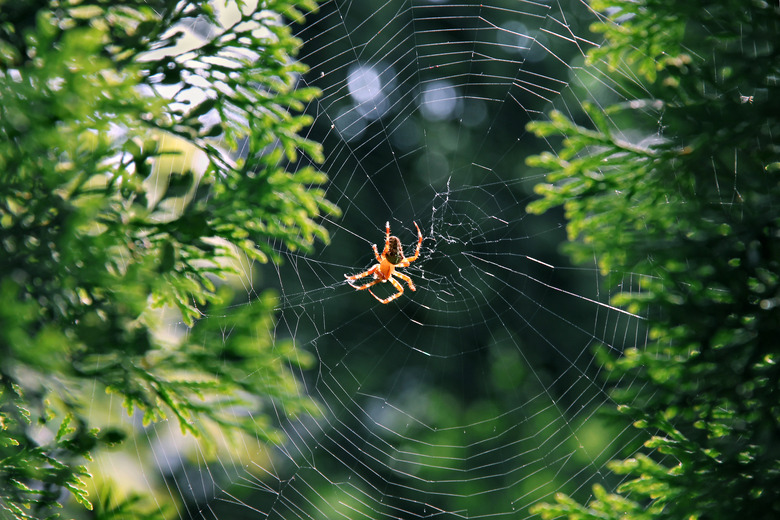The Differences Between Male & Female Spiders
When spiders are kept as pets or in labs, it's important to know their sex. Male spiders need more room to roam, and female spiders tend to be more venomous. The differences between male and female spiders (known as sexual dimorphism) depend on the species. Sometimes, the differences in male spider characteristics and female spider characteristics are obvious. In other cases, a microscope may be required.
Male Spiders Are Often Brighter in Color
Male Spiders Are Often Brighter in Color
In some spider species, the color is an instant clue to its sex – the male spider is more brightly colored than its female counterpart. One example is the black widow spider. The female is black with a red hourglass shape under her midsection, while the male is lighter in color, with red or pink spots on his back. However, the opposite is true with the golden silk spider: The female, with her orange body and yellow-spotted silver hard upper shell, is brighter than the dark brown male.
Female Spiders Are Typically Larger
Female Spiders Are Typically Larger
The female is significantly bigger than the male in most spider species. The golden silk spider is a good example: The female is approximately six times longer than the male – 3 inches long compared to his 1/2 inch. Other species with larger females than males are the black widow spider and the daring jumping spider. The difference in size makes male spiders easy prey. To stay safe, the male spider has to signal to the female that he is a spider of the same species, not food or a potential predator, and that he has mating on his mind. One theory behind the size difference in male and female spiders is that a larger female body is more advantageous when it comes to generating offspring.
Male Spiders Have Longer Legs
Male Spiders Have Longer Legs
Male spiders have longer legs, which is most likely an evolutionary characteristic as they roam farther and more frequently than females. Female spiders don't leave their webs, whereas male spiders go out hunting.
Male Spiders Have Swollen Palps
Male Spiders Have Swollen Palps
A less obvious difference between male and female spiders might require a microscope to see. At the front of the spider, where its "face" is, are two small mouthparts that look like a pair of little legs. These are pedipalps or "palps" and are used for navigating the spider's immediate environment, for holding onto prey while eating it, and in males, for depositing sperm in the female during mating. An adult male's palp tips are swollen, while those of an adult female or immature spider of either sex are not.
Female Spiders Have More Venom
Female Spiders Have More Venom
Almost all spider species are venomous, and in most cases, females have larger venom sacs than males. Some adult male spiders don't have functioning venom sacs at all. It is believed that because many female spiders don't leave their webs, they need more venom to protect their nests. Male spiders hunt while they are out roaming and have a wider choice of prey.
Female Spiders Live Longer
Female Spiders Live Longer
Most spiders only live for a few months, dying from predators, parasites or disease before they reach old age. However, spiders in captivity can live for several years, with female spiders often outliving their male counterparts. Female tarantulas can live for up to 25 years, which is 15 years longer than male tarantulas.
Cite This Article
MLA
Gillespie, Claire. "The Differences Between Male & Female Spiders" sciencing.com, https://www.sciencing.com/differences-between-male-female-spiders-8106959/. 19 April 2018.
APA
Gillespie, Claire. (2018, April 19). The Differences Between Male & Female Spiders. sciencing.com. Retrieved from https://www.sciencing.com/differences-between-male-female-spiders-8106959/
Chicago
Gillespie, Claire. The Differences Between Male & Female Spiders last modified March 24, 2022. https://www.sciencing.com/differences-between-male-female-spiders-8106959/
